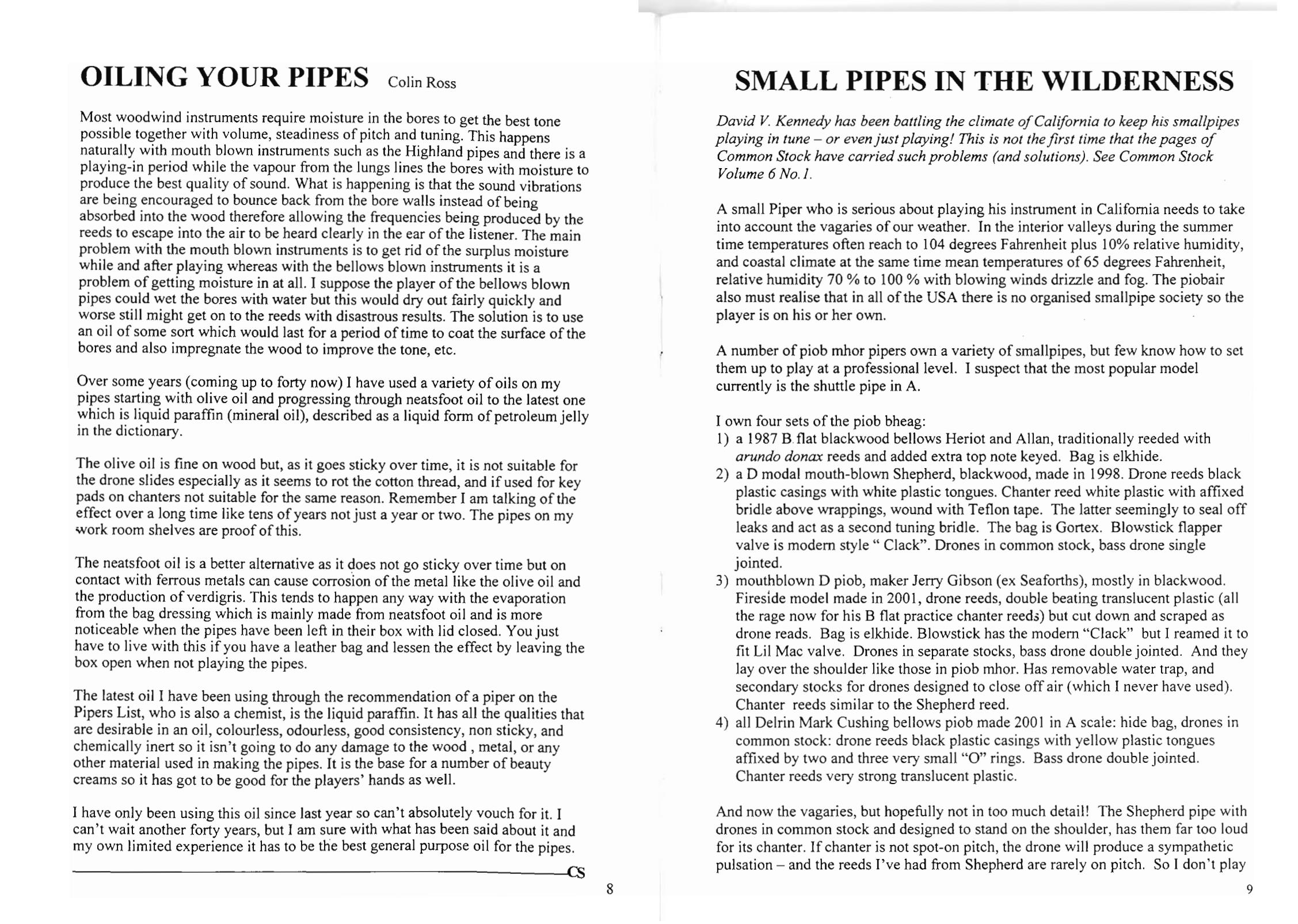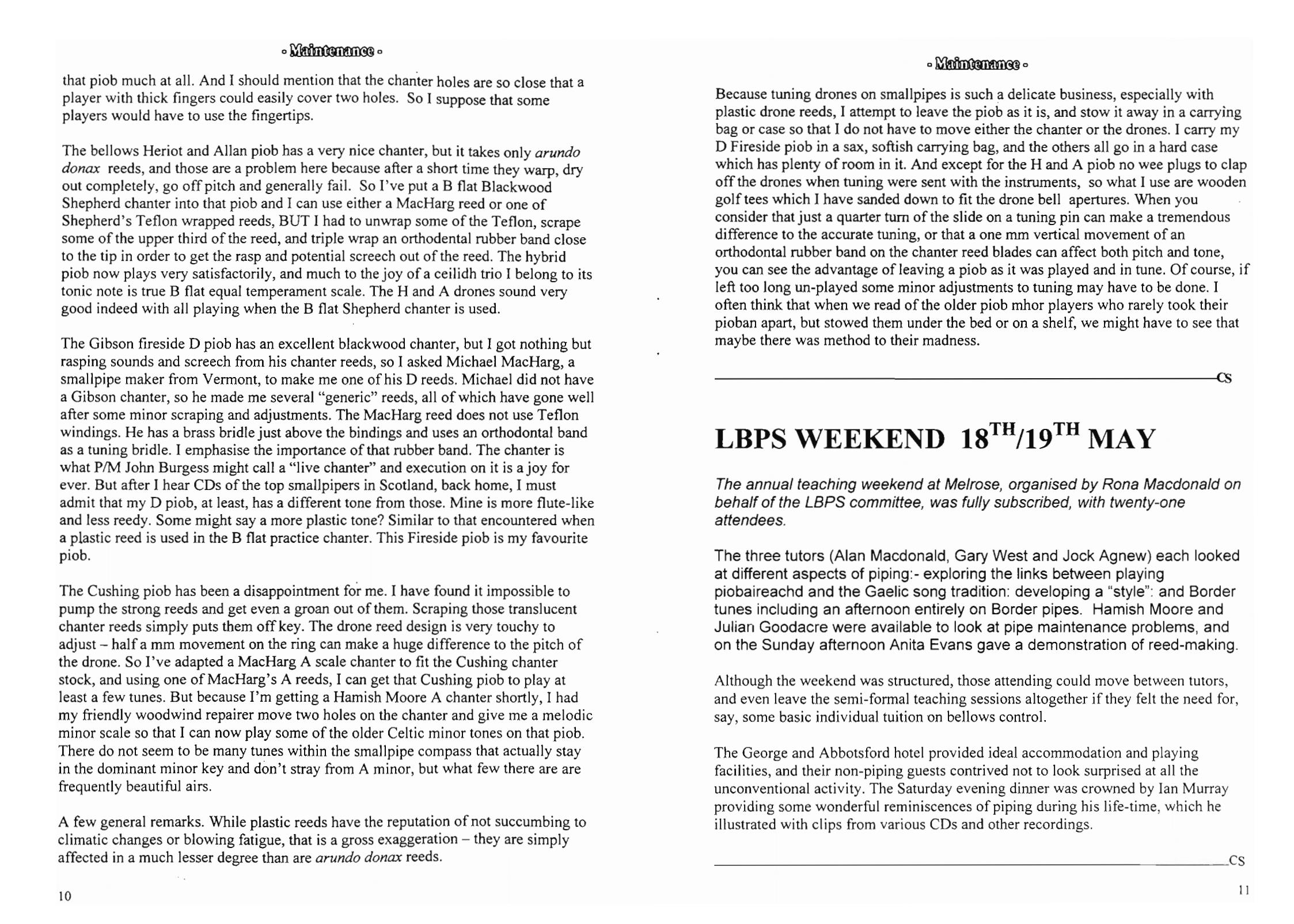Smallpipes in the Wilderness - California


David V. Kennedy has been battling the climate of California to keep his smallpipes playing in tune - or even just playing! This is not the first time that the pages of Common Stock have carried such problems (and solutions). See Common Stock Volume 6 No. 1.
A smallpiper who is serious about playing his instrument in California needs to take into account the vagaries of our weather. In the interior valleys during the summer time tempera- tures often reach to 104 degrees Fahrenheit plus 10% relative humidity, and coastal climate at the same time mean temperatures of 65 degrees Fahrenheit, relative humidity 70 % to 100 % with blowing winds drizzle and fog. The piobair also must realise that in all of the USA there is no organised smallpipe society so the player is on his or her own.
A number of piob mhor pipers own a variety of smallpipes, but few know how to set them up to play at a professional level. I suspect that the most popular model currently is the shuttle pipe in A.
I own four sets of the piob bheag:
- a 1987 B flat blackwood bellows Heriot and Allan, traditionally reeded with arundo donax reeds and added extra top note Bag is elkhide.
- a D modal mouth-blown Shepherd, blackwood, made in 1998. Drone reeds black plastic casings with white plastic tongues. Chanter reed white plastic with affixed bridle above wrappings, wound with Teflon tape. The latter seemingly to seal off leaks and act as a second tuning bridle. The bag is Blowstick flapper valve is modern style
“ Clack”. Drones in common stock, bass drone single jointed.
- mouthblown D piob, maker Jerry Gibson (ex Seaforths), mostly in blackwood. Fireside model made in 2001, drone reeds, double beating translucent plastic (all the rage now for his B flat practice chanter reeds) but cut down and scraped as drone reeds. Bag is elkhide. Blowstick has the modern “Clack” but I reamed it to fit Lil Mac valve. Drones in separate stocks, bass drone double jointed. And they lay over the shoulder like those in piob mhor. Has removable water trap, and secondary stocks for drones designed to close off air (which I never have used). Chanter reeds similar to the Shepherd
- all Delrin Mark Cushing bellows piob made 2001 in A scale: hide bag, drones in com- mon stock: drone reeds black plastic casings with yellow plastic tongues affixed by two and three very small “O” rings. Bass drone double jointed. Chanter reeds very strong translucent
And now the vagaries, but hopefully not in too much detail! The Shepherd pipe with drones in common stock and designed to stand on the shoulder, has them far too loud for its chanter. If chanter is not spot-on pitch, the drone will produce a sympathetic pulsation - and the reeds I’ve had from Shepherd are rarely on pitch. So I don’t play that piob much at all. And I should mention that the chanter holes are so close that a player with thick fingers could easily cover two holes. So I suppose that some players would have to use the finger--tips.
The bellows Heriot and Allan piob has a very nice chanter, but it takes only arundo donax reeds, and those are a problem here because after a short time they warp, dry out com- pletely, go off pitch and generally fail. So I’ve put a B flat Blackwood Shepherd chanter into that piob and I can use either a MacHarg reed or one of Shepherd’s Teflon wrapped reeds, BUT I had to unwrap some of the Teflon, scrape some of the upper third of the reed, and triple wrap an orthodental rubber band close to the tip in order to get the rasp and po- tential screech out of the reed. The hybrid piob now plays very satisfactorily, and much to the joy of a ceilidh trio I belong to its tonic note is true B flat equal temperament scale. The H and A drones sound very good indeed with all playing when the B flat Shepherd chanter is used.
The Gibson fireside D piob has an excellent blackwood chanter, but I got nothing but rasp- ing sounds and screech from his chanter reeds, so I asked Michael MacHarg, a smallpipe maker from Vermont, to make me one of his D reeds. Michael did not have a Gibson chanter, so he made me several “generic” reeds, all of which have gone well after some minor scraping and adjustments.
The MacHarg reed does not use Teflon windings. He has a brass bridle just above the bind- ings and uses an orthodontal band as a tuning bridle. I emphasise the importance of that rub- ber band. The chanter is what P/M John Burgess might call a “live chanter” and execution on it is a joy for ever. But after I hear CDs of the top smallpipers in Scotland, back home, I must admit that my D piob, at least, has a different tone from those. Mine is more flute-like and less reedy. Some might say a more plastic tone? Similar to that encountered when a plastic reed is used in the B flat practice chanter. This Fireside piob is my favourite piob.
The Cushing piob has been a disappointment for me. I have found it impossible to pump the strong reeds and get even a groan out of them. Scraping those translucent chanter reeds sim- ply puts them off key. The drone reed design is very touchy to adjust - half a mm movement on the ring can make a huge difference to the pitch of the drone. So I’ve adapted a MacHarg A scale chanter to fit the Cushing chanter stock, and using one of MacHarg’s A reeds, I can get that Cushing piob to play at least a few tunes.
But because I’m getting a Hamish Moore A chanter shortly, I had my friendly woodwind repairer move two holes on the chanter and give me a melodic minor scale so that I can now play some of the older Celtic minor tones on that piob. There do not seem to be many tunes within the smallpipe compass that actually stay in the dominant minor key and don’t stray from A minor, but what few there are, are frequently beautiful airs.
A few general remarks. While plastic reeds have the reputation of not succumbing to cli- matic changes or blowing fatigue, that is a gross exaggeration - they are simply affected in a much lesser degree than are arundo donax reeds.
Because tuning drones on smallpipes is such a delicate business, especially with plastic drone reeds, I attempt to leave the piob as it is, and stow it away in a carrying bag or case so that I do not have to move either the chanter or the drones. I carry my D Fireside piob in a sax, softish carrying bag, and the others all go in a hard case which has plenty of room in it.
And except for the H and A piob no wee plugs to clap off the drones when tuning were sent with the instruments, so what I use are wooden golf tees which I have sanded down to fit the drone bell apertures.
When you consider that just a quarter turn of the slide on a tuning pin can make a tremen- dous difference to the accurate tuning, or that a one mm vertical movement of an orthodon- tal rubber band on the chanter reed blades can affect both pitch and tone, you can see the advantage of leaving a piob as it was played and in tune.
Of course, if left too long unplayed some minor adjustments to tuning may have to be done. I often think that when we read of the older piob mhor players who rarely took their pioban apart, but stowed them under the bed or on a shelf, we might have to see that maybe there was method to their madness.
